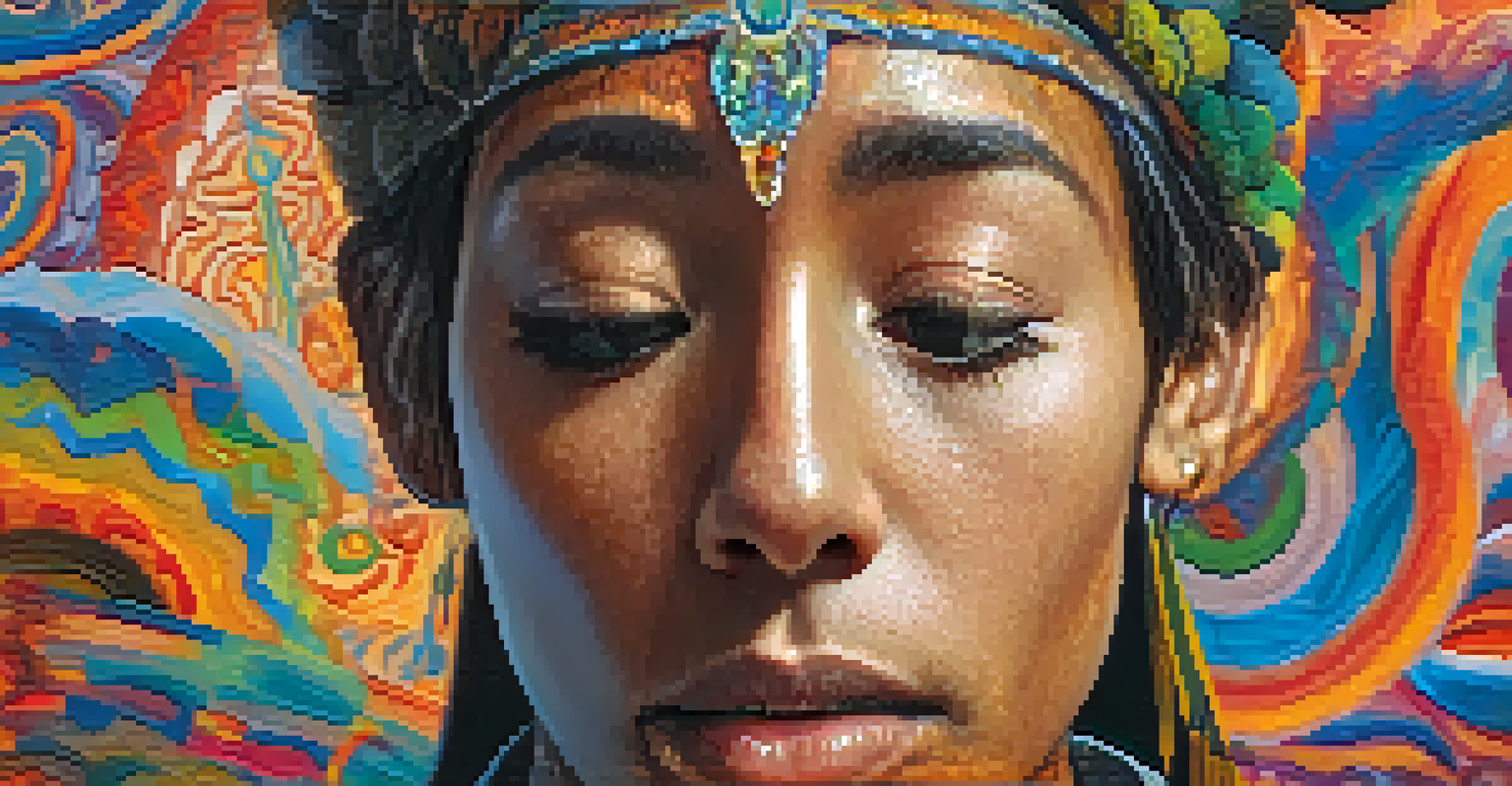Psychedelics Meet Psychotherapy: Ayahuasca in Western Contexts

Understanding Ayahuasca: Origins and Components
Ayahuasca is a powerful brew traditionally used by indigenous tribes in the Amazon. It combines two main ingredients: the Banisteriopsis caapi vine and the leaves of the Psychotria viridis plant. This concoction creates a unique psychoactive experience due to the presence of DMT (dimethyltryptamine), which is known for its intense hallucinogenic effects.
The use of ayahuasca as a therapeutic tool is a powerful reminder of how indigenous knowledge can inform contemporary healing practices.
The historical use of ayahuasca in shamanic rituals highlights its significance in spiritual and healing practices. Shamans would guide individuals through the experience, providing support and interpretations of visions encountered during the journey. This deep-rooted tradition emphasizes the importance of community and ritual in the healing process.
As ayahuasca gains popularity in Western contexts, understanding its origins and the cultural significance is vital. It’s not just a substance; it’s a vehicle for exploring consciousness and promoting healing, and this requires a respectful approach to its use outside of its traditional settings.
The Rise of Psychedelic Therapy in Western Medicine
Psychedelic therapy is experiencing a renaissance in Western medicine, with ayahuasca at the forefront. Research suggests that psychedelics can help treat various mental health issues, including depression, anxiety, and PTSD. This shift in perspective is partly due to promising clinical trials and a growing body of anecdotal evidence from users.

As mental health challenges rise globally, traditional therapies are often found lacking. The integration of psychedelics, including ayahuasca, offers a new avenue for healing that resonates with those seeking alternative solutions. Advocates argue that psychedelics can facilitate profound emotional breakthroughs and insights that conventional therapies might miss.
Ayahuasca's Healing Traditions
Ayahuasca is deeply rooted in indigenous cultures as a tool for spiritual healing, emphasizing the importance of community and ritual.
This movement, however, is not without its controversies. Critics caution against the potential for misuse and emphasize the need for strict guidelines and trained professionals to ensure safety and efficacy during these experiences.
Ayahuasca Retreats: A New Trend in Healing
Ayahuasca retreats have surged in popularity, often set in tranquil, natural environments designed for introspection and healing. Participants from various backgrounds travel to these retreats, seeking transformational experiences. These settings aim to replicate the traditional shamanic journeys while providing a safe space for exploration.
Psychedelics can be a catalyst for emotional breakthroughs, offering insights that traditional therapies might overlook.
Typically, a trained facilitator or shaman leads the sessions, creating an environment that encourages openness and trust. The experience often involves multiple ceremonies over several days, allowing participants to process their insights and emotions. This structured approach helps individuals integrate their experiences into their lives.
However, it’s essential to approach these retreats with caution. Not all retreats adhere to the same standards, and potential participants should thoroughly research facilitators and their practices to ensure a safe and genuine experience.
The Science Behind Ayahuasca: Exploring Its Effects
Scientific research into ayahuasca is still in its early stages, but findings have been promising. Studies indicate that the brew can alter brain connectivity and enhance emotional processing. This neuroplasticity may allow individuals to reframe traumatic experiences and foster personal growth, paving the way for healing.
Moreover, ayahuasca has been shown to increase serotonin levels, contributing to improved mood and emotional wellbeing. These biochemical changes can provide relief for those struggling with mental health issues. Understanding these effects helps demystify the experience and reinforces its therapeutic potential.
Psychedelics in Western Therapy
The rise of psychedelic therapy, including ayahuasca, offers new hope for treating mental health issues, providing emotional breakthroughs that traditional therapies may overlook.
Despite the positive outlook, it’s crucial to remember that individual experiences can vary widely. What may be healing for one person could be distressing for another, emphasizing the importance of preparation and support throughout the journey.
Integration: Essential After an Ayahuasca Experience
The integration phase after an ayahuasca experience is a critical aspect of the healing process. This involves reflecting on insights gained during the ceremony and finding ways to incorporate them into daily life. Without proper integration, individuals might struggle to make sense of their experiences, leading to confusion or emotional distress.
Many retreats offer integration circles, where participants can share their experiences and support one another. This communal aspect mirrors the traditional practices of indigenous cultures, fostering a sense of belonging and understanding. Connecting with others who have undergone similar journeys can be incredibly therapeutic.
In addition to group support, personal practices such as journaling, meditation, or therapy can aid in integration. These methods provide a space for individuals to process their thoughts and emotions, ultimately enhancing the overall healing journey.
Legal and Ethical Considerations Surrounding Ayahuasca
As ayahuasca becomes more popular in Western contexts, legal and ethical issues are emerging. In many countries, the brew remains illegal due to its DMT content, which is classified as a controlled substance. This legal gray area raises questions about accessibility, safety, and the potential for exploitation.
Moreover, the commercialization of ayahuasca retreats can lead to ethical dilemmas. Some facilitators may prioritize profit over genuine healing, resulting in inadequate support for participants. It’s crucial for individuals to be discerning and prioritize their safety and well-being when seeking these experiences.
Importance of Integration Phase
Post-ayahuasca integration is crucial for processing experiences, and involves sharing insights and personal practices to enhance healing.
Navigating the legal landscape and ensuring ethical practices is essential for the responsible use of ayahuasca in therapy. This ongoing conversation will shape the future of psychedelics in mental health care and guide individuals toward safe and meaningful experiences.
The Future of Ayahuasca in Western Psychotherapy
The future of ayahuasca in Western psychotherapy looks promising as more research and understanding emerge. As mental health paradigms shift, psychedelics may become an integral part of therapeutic practices. This evolution could change how we approach healing, emphasizing holistic methods that consider emotional, psychological, and spiritual dimensions.
Collaboration between traditional practices and modern psychology can enhance the therapeutic landscape. By respecting indigenous wisdom while integrating scientific insights, practitioners can create more comprehensive treatment plans. This synergy could provide individuals with a richer healing experience.

Ultimately, the journey of ayahuasca in Western contexts is just beginning. With ongoing research, ethical considerations, and community support, ayahuasca has the potential to reshape our understanding of mental health and healing.